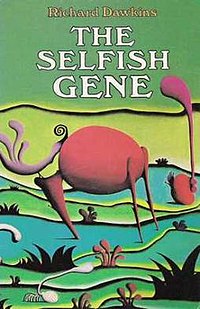From Wikipedia, the free encyclopedia

Original cover, with details from the painting The Expectant Valley by zoologist Desmond Morris.
|
|
| Author | Richard Dawkins |
|---|---|
| Subject | Evolutionary biology |
| Publisher | Oxford University Press |
Publication date
|
1976 Second edition in 1989 Third edition in 2006 |
| Pages | 224 |
| ISBN | ISBN 0-19-857519-X |
| OCLC | 2681149 |
| Followed by | The Extended Phenotype |
The Selfish Gene is a book on evolution by Richard Dawkins, published in 1976. It builds upon the principal theory of George C. Williams's first book Adaptation and Natural Selection. Dawkins used the term "selfish gene" as a way of expressing the gene-centred view of evolution as opposed to the views focused on the organism and the group, popularising ideas developed during the 1960s by W. D. Hamilton and others. From the gene-centred view follows that the more two individuals are genetically related, the more sense (at the level of the genes) it makes for them to behave selflessly with each other. Therefore the concept is especially good at explaining many forms of altruism. This should not be confused with misuse of the term along the lines of a selfishness gene.
An organism is expected to evolve to maximise its inclusive fitness—the number of copies of its genes passed on globally (rather than by a particular individual). As a result, populations will tend towards an evolutionarily stable strategy. The book also coins the term meme for a unit of human cultural evolution analogous to the gene, suggesting that such "selfish" replication may also model human culture, in a different sense. Memetics has become the subject of many studies since the publication of the book.
In the foreword to the book's 30th-anniversary edition, Dawkins said he "can readily see that [the book's title] might give an inadequate impression of its contents" and in retrospect thinks he should have taken Tom Maschler's advice and called the book The Immortal Gene.[1]
"Selfish" genes
In describing genes as being "selfish", the author does not intend (as he states unequivocally) to imply that they are driven by any motives or will, but merely that their effects can be metaphorically and pedagogically described as if they were. The contention is that the genes that get passed on are the ones whose evolutionary consequences serve their own implicit interests (to continue being replicated), not necessarily those of the organism. Bringing the level of evolutionary dynamics down to the single gene, or complementary genes which work well together in a given type of organism, Dawkins categorically rejects the school of thought which tells that evolution operates on the level of social group.This view is said to explain altruism at the individual level in nature, especially in kinship relationships: when an individual sacrifices its own life to protect the lives of kin, it is acting in the interest of its own genes. Some people find this metaphor entirely clear, while others find it confusing, misleading or simply redundant to ascribe mental attributes to something that is mindless.
For example, Andrew Brown has written:
"Selfish", when applied to genes, doesn't mean "selfish" at all. It means, instead, an extremely important quality for which there is no good word in the English language: "the quality of being copied by a Darwinian selection process." This is a complicated mouthful. There ought to be a better, shorter word—but "selfish" isn't it.[2]Donald Symons also finds it inappropriate to use everyday language in conveying scientific meaning in general and particularly for the present instance:
In summary, the rhetoric of The Selfish Gene exactly reverses the real situation: through metaphor genes are endowed with properties only sentient beings can possess, such as selfishness, while sentient beings are stripped of these properties and called machines (robots).[3]
Genes and selection
Dawkins proposes the idea of the "replicator,"[4] the initial molecule which first managed to reproduce itself and thus gained an advantage over other molecules within the primordial soup.[5] As replicating molecules became more complex, Dawkins postulates, the replicators became the genes within organisms, with each organism's body serving the purpose of a 'survival machine' for its genes.Dawkins writes that gene combinations which help an organism to survive and reproduce tend to also improve the gene's own chances of being passed on and, as a result, frequently "successful" genes will also be beneficial to the organism. An example of this might be a gene that protects the organism against a disease, which helps the gene spread and also helps the organism.
Genes can reproduce at the expense of the organism
There are other times when the implicit interests of the vehicle and replicator are in conflict, such as the genes behind certain male spiders' instinctive mating behaviour, which increase the organism's inclusive fitness by allowing it to reproduce, but shorten its life by exposing it to the risk of being eaten by the cannibalistic female. Another good example is the existence of segregation distortion genes that are detrimental to their host but nonetheless propagate themselves at its expense. Likewise, the existence of junk DNA that provides no benefit to its host, once a puzzle, can be more easily explained.[6]Power struggles are rare
These examples might suggest that there is a power-struggle between genes and their host. In fact, the claim is that there isn't much of a struggle because the genes usually win without a fight. Only if the organism becomes intelligent enough to understand its own interests, as distinct from those of its genes, can there be true conflict.An example of this conflict might be a person using birth control to prevent fertilisation, thereby inhibiting the replication of his or her genes.
But that may not be a conflict of the 'self-interest' of the organism with his or her genes, since a person using birth control may also be enhancing the survival chances of their genes by limiting family size to conform with available resources, thus avoiding extinction as predicted under the Malthusian model of population growth.
Many phenomena explained
When examined from the standpoint of gene selection, many biological phenomena that, in prior models, were difficult to explain become easier to understand. In particular, phenomena such as kin selection and eusociality, where organisms act altruistically, against their individual interests (in the sense of health, safety or personal reproduction) to help related organisms reproduce, can be explained as gene sets "helping" copies of themselves (or sequences with the same phenotypic effect) in other bodies to replicate. Interestingly, the "selfish" actions of genes lead to unselfish actions by organisms.Prior to the 1960s, it was common for such behaviour to be explained in terms of group selection, where the benefits to the organism or even population were supposed to account for the popularity of the genes responsible for the tendency towards that behaviour. This was shown not to be an evolutionarily stable strategy, in that it would only take a single individual with a tendency towards more selfish behaviour to undermine a population otherwise filled only with the gene for altruism towards non-kin.
Reception
The book was extremely popular when first published, caused "a silent and almost immediate revolution in biology",[7] and continues to be widely read. It has sold over a million copies, and has been translated into more than 25 languages.[8]Proponents argue that the central point, that the gene is the unit of selection, usefully completes and extends the explanation of evolution given by Charles Darwin before the basic mechanisms of genetics were understood. Critics argue that it oversimplifies the relationship between genes and the organism. Mathematical biologists' initial relationship with the ideas in the book was, according to Alan Grafen, "at best difficult" due to what Grafen postulates is a reliance solely on Mendelian genetics by these biologists.[9]
In 1976, Arthur Cain, one of Dawkins's tutors at Oxford in the 1960s, called it a "young man's book" (which Dawkins points out was a deliberate quote of a commentator on A.J. Ayer's Language, Truth, and Logic); Dawkins later noted he had been "flattered by the comparison, [but] knew that Ayer had recanted much of his first book and [he] could hardly miss Cain's pointed implication that [he] should, in the fullness of time, do the same."[1]
Other types of selection suggested
Most modern evolutionary biologists accept that the idea is consistent with many processes in evolution. However, the view that selection on other levels, such as organisms and populations, seldom opposes selection on genes is more controversial. While naïve versions of group selectionism have been disproved, more sophisticated formulations make accurate predictions in some cases while positing selection at higher levels.[10] Nevertheless, the explanatory gains of using sophisticated formulations of group selectionism as opposed to Dawkins's gene-centred selectionism are still under dispute. Both sides agree that very favourable genes are likely to prosper and replicate if they arise and both sides agree that living in groups can be an advantage to the group members. The conflict arises not so much over disputes on hard facts but over what is the best way of viewing evolutionary selection in animals.In "The Social Conquest of Earth," E. O. Wilson contends that kin selection as described in "The Selfish Gene" is a largely ineffective model of social evolution. Chapter 18 of "The Social Conquest of Earth" describes the deficiencies of kin selection and outlines group selection, which Wilson argues is a more realistic model of social evolution. He writes, "...unwarranted faith in the central role of kinship in social evolution has led to the reversal of the usual order in which biological research is conducted. The proven best way in evolutionary biology, as in most of science, is to define a problem arising during empirical research, then select or devise the theory that is needed to solve it. Almost all research in inclusive-fitness theory [such as in "The Selfish Gene"] has been the opposite: hypothesize the key roles of kinship and kin selection, then look for evidence to test that hypothesis."[11]
Unit of selection or of evolution
Some biologists have criticised the idea for describing the gene as the unit of selection, but suggest describing the gene as the unit of evolution, on the grounds that selection is a "here and now" event of reproduction and survival, while evolution is the long-term trend of shifting allele frequencies.[12]Stephen Jay Gould also took issue with the gene as the unit of selection, arguing that genes are not directly 'visible' to natural selection. Rather, the unit of selection is the phenotype, not the genotype, because it is phenotypes which interact with the environment at the natural selection interface.[13] As Kim Sterelny[14] summarises Gould's view, "Gene differences do not cause evolutionary changes in populations, they register those changes". This is also Niles Eldredge's view. Eldredge[15] notes that in Dawkins' book A Devil's Chaplain, which was published just before Eldredge's book, "Richard Dawkins comments on what he sees as the main difference between his position and that of the late Stephen Jay Gould. He concludes that it is his own vision that genes play a causal role in evolution", while Gould (and Eldredge) "sees genes as passive recorders of what worked better than what".







